Origin and age of lakes
| Topics: |
Geology (main)
|
Contents
Introduction (Source: Biodiversity Institute of Ontario (Origin and age of lakes) )
Lakes are formed by geological, climatological, biological, and extraterrestrial (meteorites) mechanisms. While most lakes are formed by catastrophic events, others are created more gradually.
Lakes formed by catastrophic events
Lakes of glacial origin
By far the most productive maker of present-day lakes were the glaciers. Between one million and ten thousand years ago, during the Pleistocene, our planet experienced a series of four ice ages (expansions and recessions of glacial ice over the land surface). At times of maximal ice cover, 31.5% of the earth's surface was covered by glaciers. The last glaciation (called the "Wisconsinan" - 10,000 to 125,000 years ago) was responsible for shaping the landscape of northern temperate regions. It created the vast majority of lakes now present in Canada, including the Great Lakes. Today, glaciers cover about 10% of the earth's surface and persist only in areas with abundant snowfall.
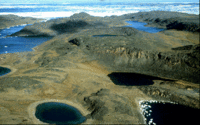 (Source: Biodiversity Institute of Ontario)
(Source: Biodiversity Institute of Ontario) Lakes formed by existing glaciers
Thermokarst lakes
 (Source: Biodiversity Institute of Ontario)
(Source: Biodiversity Institute of Ontario) Thermokarst Lakes form by water seepage through cracks in the ground into the permafrost, which on freezing, forms a polygonic network of ridges that contain subsequent meltwater. Repeated freeze thaw cycles can lead to expansion of these water filled cracks into a lake. A large number of arctic thaw lakes have an elliptical shape, with the long axis in the northeast/southwest direction across the prevailing winds. This orientation arises because currents produced by wind action erode and thaw permafrost at ends of the long axis of the ellipse lying across the wind. Thermokarst lakes are formed in Arctic when large amounts of ice deep in the permafrost melt, especially if plant cover is disturbed or destroyed.
Formed by past glaciers
Ground Moraine Lakes
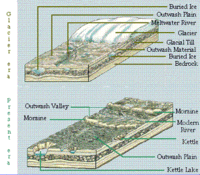 (Source: Biodiversity Institute of Ontario)
(Source: Biodiversity Institute of Ontario) Ground moraine is the general term used for any accumulation of glacial origin including boulders, sand, and gravel, left on a surface over where a glacier was formerly present.
Kettle Lakes occupy depressions produced by the melting of large chunks of ice that were left within the ground moraine when its parent glacier melted. Kettle lakes are common in low relief areas such as the outwash plains in the Mackenzie Delta. Kettle lakes do not necessarily form immediately after the glacier's recession. If the ice chunk is insulated by an overburden of drift, it can persist long after its parent glacier has disappeared.
Lakes formed by morainal impoundment develop in mountainous regions where terminal and lateral moraines dam a river valley.
Lakes formed by hydraulic force on a ground moraine form during temporary decreases in the rate of glacial melting when recessional moraines were left behind. Meltwater, streaming under pressure beneath the ice, washed out deep elongate basins in the drift and lakes occupy these depressions today.
Glacial Scour Lakes
Glacial Scour Lakes formed when glaciers eroded bedrock, carving basins that are now filled with rainwater. The Great Lakes are examples of glacial scour lakes.
Fiord Lakes develop when fiords rise above sea level as a result of isostatic rebound (uplift of land after being depressed by ice). Fiords were formed in western Canada within narrow, deep basins in glacially deepened valleys and are also found extensively throughout coastal regions of the eastern Arctic.
Cirque Lakes are ice scour lakes that form in the upper portion of mountainous areas where lakes occupy amphitheater-shaped depressions formed by the erosional action of mountain glaciers.
Paternoster Lakes is the name given to a series of cirque lakes at successively lower elevations. Viewed from the air, they look like a string of silvery beads and gain their name from this fact.
Glacial Relict Lakes
Glacial Relict Lakes are remnants of giant lakes that were once filled with glacial meltwater but now exist as separate bodies of water. An enormous lake, Lake Agassiz, formed in North America from the retreating Wisconsinian ice sheet that covered 540 000 square kilometers from eastern Saskatchewan to western Ontario and south to include eastern North Dakota and northwestern Minnesota. The modern remnants of this lake include Lakes Winnipeg, Manitoba, Nipigon, and Lake-of-the-Woods.
Tectonic Lakes
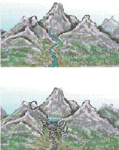 (Source: Biodiversity Institute of Ontario)
(Source: Biodiversity Institute of Ontario) Tectonic Lakes are formed by movements of the earth's crust in such a way as to create a basin that can fill with water. Uplifting of the earth has created a number of lakes that were often modified by glacial scouring activity. Lake Superior is of mixed glacial and tectonic origins.
Lakes created by landslides
Lakes Created by Landslides form in stream valleys behind the dam created by a landslide.
Lakes created by meteorites
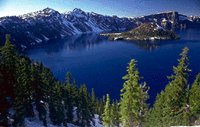 (Source: Biodiversity Institute of Ontario)
(Source: Biodiversity Institute of Ontario) Lakes Created by the Impact and Explosion of Meteorites are characterized by a high rim and circular outline. Both New Quebec Crater Lake on the Ungava Peninsula in Quebec and Crater Lake in Oregon, U.S.A. are of meteoritic origin.
Lakes formed by gradual events
Saline lakes
Saline Lakes are found in areas with closed watersheds (no tributaries leave the lake). In Canada, saline lakes are largely confined to the arid regions of southern Alberta and Saskatchewan. One of best known saline lakes is Little Manitou, Saskatchewan, which has a salinity greater than that of the ocean. This lake does not have any [[stream]s] that drain it, and constant evaporation year after year increases the salt content almost to saturation point. Another example is Patience Lake (Sask.).
Lake Basins Formed by River Activity
 (Source: Biodiversity Institute of Ontario)
(Source: Biodiversity Institute of Ontario) Lake Basins Formed by River Activity where the erosional and depositional action of river water can isolate depressions to form lakes (e.g. plunge-pool lakes below former waterfalls and oxbow lakes in former river channels, such as those along the Mackenzie River).
Lakes of Aeolian Origin
Lakes of Aeolian Origin are formed when wind erosion creates shallow depressions which contain water seasonally (e.g. temporary Dune lakes in sandy areas).
Coastal Lakes
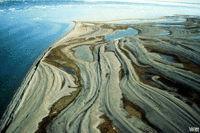 (Source: Biodiversity Institute of Ontario)
(Source: Biodiversity Institute of Ontario) Coastal Lakes often form along irregularities in the shoreline of the sea or large lakes. Longshore currents deposit sediments in bars or spits that eventually isolate a fresh or brackish water lake. Many of the marshes at Point Pelee on Lake Erie were formed by the action of longshore currents. Isostatic rebound (uplift of land after being depressed by ice) in the eastern Arctic has resulted in the formation of large numbers of shallow lakes behind beach ridges which were offshore bars exposed through uplift.
Lakes created by plants and animals
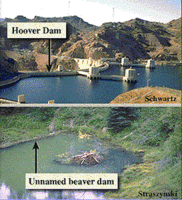 (Source: Biodiversity Institute of Ontario)
(Source: Biodiversity Institute of Ontario) Lakes Created by Plants and Animals can be formed in different ways. Dams of Sphagnum sp. (moss) and other bog plants (Aquatic plants) have also been reported to impound some lakes in Nova Scotia. The damming activity of beavers results in the impoundment of [[stream]s] with subsequent flooding of the landscape. Reservoirs are impoundments created by humans through the damming of river valleys. Because of high rates of sedimentation, reservoirs tend to be short-lived.
Death of a lake
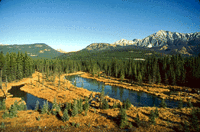 (Source: Biodiversity Institute of Ontario)
(Source: Biodiversity Institute of Ontario) Once a lake is formed, it is doomed. The concave nature of a lake's basin leads it to accumulate sediments, leading its eventual death. Both allochthonous materials brought in by wind and erosion and autochthonous materials formed within the lake contribute to the bottom sediments. Eventually, marshes, meadows and forests grow on what was once a lake. Some lakes are fleeting features of the landscape but others occupy such deep depressions that millions of years are required for their filling.
1 Comment
Donald Sullivan wrote: 01-07-2013 12:05:30
A couple of corrections: the number of glaciations during the Pleistocene is more on the order of 16-20. The old "four-glacial" model has been discarded for decades. Also, Crater Lake is clearly not in an impact crater. The lake formed in the crater of the Mount Mazama volcano (volcanic lakes is another category not mentioned in the article). Finally, another category of lakes are those formed by faulting. Lateral, thrust, and normal faults can all produce lakes. Examples include Mono Lake, California, Lake Baikal, Russia, etc.